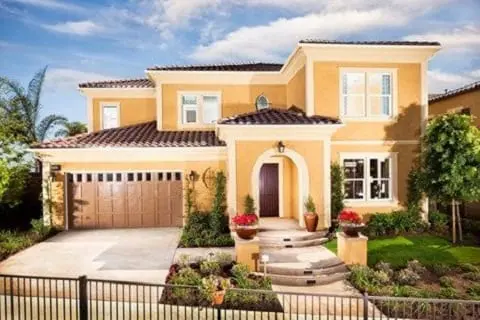
By Drew Knight
When you buy a new home, you might spend a lot of the time picking out appliances, furniture, décor and more for the interior that you may be so worn out that you don’t even want to begin thinking about the exterior.
However, improving curb appeal and landscaping can add tremendous value to your home. We’ve talked with several experts and compiled a list of tips that will make approaching your front-yard design a seamless process.
Make It Your Own
“Even if you’re not selling your house any time soon, pulling up to an attractive house is a warm and comforting feeling for you and your family, any time,” says Jennifer Adams, CEO of home décor brand Jennifer Adams Worldwide Inc. and former designer on the HGTV show My First Place.
Here’s why she suggests these tips on adding curb appeal to any home — new or resale:
De-Clutter Your Porch
Clutter is stressful, no matter where you see it. Store the recycling elsewhere, compost any dead plants, clean the porch light, move the toys to the garage or donate them and fix or remove the screen door.
Paint the Front Door
Go bold and bright — a bright color that contrasts with the rest of the house is charming. For a rich, sophisticated look, choose a darker shade of some other color on your house.
Add Seating
Porch furniture such as rocking chair, a bench or stool implies relaxation and leisure and makes a great place to set a grocery bag when you’re fumbling with house keys or your phone.
Add Interesting Artifacts Instead of High-Maintenance Flowerpots
Why fuss with flowers? Adding your own unique décor adds personality. An antique milk jug, an interesting stone or fountain, a large “bouquet” of sticks in an urn, a charming bench or table need no maintenance, look better with age and add interest without any of that pesky watering, fertilizing or weeding schedules!
Keep Your Porch Light On
Or put it on a timer. Use an energy-efficient LED or CFL bulb. Not only is light welcoming, it’s a safety thing. You can easily see where you’re going and it helps your house look occupied even if you’re gone.
Launch Into Landscaping
The next place to begin is to plan out your landscaping.
Josh Kane, president and head designer of Kane Landscapes in Sterling, Va., and member of The National Association of Landscape Professionals, suggests starting by checking out websites or magazines to find a unique style.
“Once they have a general idea of the style and some of the plants they like, they should visit a garden center and look at some plants they like, then contact a landscape architect or design professional to help them properly design the space and make sure the plants they like will do well in their yard,” he says. For those in ranging climates, Kane suggests contacting the local extension agent or garden centers for information on selecting the right vegetation.
He says the quickest and easiest way to boost curb appeal is to maintain a green, healthy and weed-free lawn. This is particularly important to new homebuyers who plan to sell their home within a few years of moving in.
“The lawn/landscape is the first thing any potential buyer sees as they drive up to your home,” he says. “If you don’t take care of your lawn and landscape, they may assume you did not take care of other basic maintenance items for your home … or may be turned off and not even enter your open house.”
Abide By HOA Regulations
Now, wait up a moment. Before you get into painting your exterior or go crazy installing garden beds, you need to check and see if your new community has a homeowners association, or HOA, that can legally issue fines if you don’t abide by their rules.
Sandy Arons, a master gardener who happens to be the president of her neighborhood HOA in Brentwood, Tenn., says HOA rules include following the covenants regarding the outward appearance of your home and building requirements from size, color, external building materials, type of windows and much more.
“The covenants are there to ensure your home is harmonious with other homes in the neighborhood and you keep your lot and home maintained because these things affect property values,” she says.
Arons says one of the most common violations that come through HOAs often involve not getting prior approval before landscaping is installed. Working with an HOA-authorized landscape architect to get approval is a good place to start (be aware that not all HOAs provide such a service).
“Many times the landscape architect makes improvements to the plans,” she says. “These improvements include substituting plant material that will do better in our climate, revising the shapes of beds to be more appealing and any other subtle changes that can have a big impact on curb appeal.”
Though, when getting an approval, Arons says it’s a “win-win” solution. “The homeowners get a credentialed professional’s advice at no cost and the neighborhood benefits from a better-looking home.”
She advises anyone who plans to make major changes to their landscape or home exterior to gain approval from their HOA or Architectural Review Committee, which only meets once per month in some communities.
A well-thought-out landscape plan adds curb appeal to your new home and provides a stress-free way to enjoy your outdoor space. With these quick and simple tips, you will be well on your way to a front-yard design that’s appealing and enjoyable.